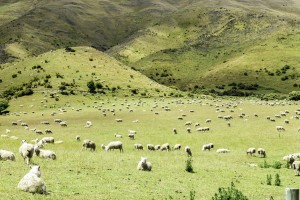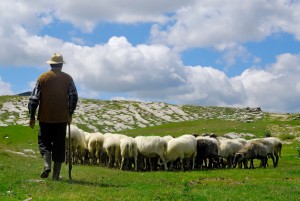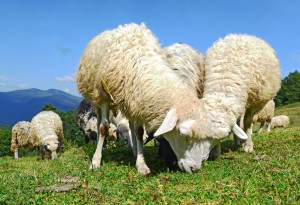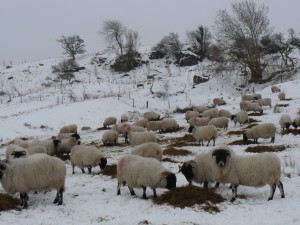Extensive Sheep Farming
 These are systems whereby animals spend all, or a substantial part, of each day outdoors and obtain most of their nutrients from pasture. In many ways, extensive systems of sheep production that we find in the mountains, moors and rangelands across the world can be considered as natural systems of farming. The animals are less under our control than intensively farmed animals and they have more freedom to express and control their behaviour. Perhaps the greatest threat to sheep in extensive environments comes from variable climate and availability of adequate or suitable nutrition (Waterhouse, 1996).
These are systems whereby animals spend all, or a substantial part, of each day outdoors and obtain most of their nutrients from pasture. In many ways, extensive systems of sheep production that we find in the mountains, moors and rangelands across the world can be considered as natural systems of farming. The animals are less under our control than intensively farmed animals and they have more freedom to express and control their behaviour. Perhaps the greatest threat to sheep in extensive environments comes from variable climate and availability of adequate or suitable nutrition (Waterhouse, 1996).
The supply of nutrients and the degree of human care and supervision in extensive grassland systems are very different from those we find in intensive farming, and as a consequence, there are differences in the welfare issues that arise. Extensive grazing also plays a crucial role in maintaining the ecology and landscape of these semi-natural pastoral ecosystems (Waterhouse, 1996).
In this section we consider the specific issues related with shepherding, nutrition, breeding, predation and health planning.
Shepherding and Human Contact
Although some extensive sheep farms have relatively high management inputs, including ultrasound scanning, moving ewes to preferential grazing areas, the provision of winter housing and at lambing and providing supplementary feeding, being extensive, there is also less opportunity for human-animal interaction and for sheep to get used to the presence and actions of humans (Goddard et al., 2006).
Infrequent handling can mean sheep becoming averse to human contact and this situation may be worsened if, under extensive management, a high number of handling procedures are carried out at any one time (Hargreaves and Hutson, 1990). This can create very stressful situations. However, conversely, under some extensive systems with low management inputs, weaning often takes place naturally and when milk production is starting to cease. Since milk yield in the ewe is a major determinant of the strength of the ewe-lamb bond (Arnold et al., 1979), the stress inflicted on the lamb is significantly reduced.
The incidence of lameness and parasitism in extensive flocks may be indicative of chronic stress worsened when there is infrequent and sporadic care-taking and shepherding. Neonatal mortality of lambs may also be associated with under-nutrition (Dwyer, 2003) and predation, again potentially exacerbated by the lack of human supervision (Goddard et al., 1996). The speed newborn lambs stand and suck is critical to their survival under extensive conditions. In some situations, ultrasound scanning technology to identify the additional nutritional needs of twin carrying ewes has enabled improvements in lamb mortality by targeting feed supplementation (Waterhouse, 1996).
Visit the Shepherding and Lambing sections for more on reducing lamb mortality.
 Grazing and Nutrition
Grazing and Nutrition
In extensive situations sheep are often foragers, seeking their nutrition mainly from pastures with multiple plant species. The decisions as to what to eat and for how long to eat it will probably be influenced by a range of considerations, including the relative nutritional qualities of what is available, how much of it is available, including the time it takes to search for and consume it, how easily it can be digested and whether it contains poisonous compounds or not.
Supplementation during times of feed shortage, especially during pregnancy and lactation, may be necessary in many systems to maintain production and to ensure the welfare of the sheep is not compromised (Frutos et al., 1998). Body condition scoring can be an effective monitoring tool to aid in nutritional management of extensively managed flocks (Morgan-Davies et al., 2008).
Selection and Breeding
Sheep populations that have undergone rigorous selection for ease of lambing and minimal shepherding in extensive environments will have well- physical and behavioural characteristics that predispose them to improved lamb survival. Under such conditions, human intervention at lambing can be potentially harmful and may result in delaying or extending the birth as well as disrupting the ewe-lamb bonding (Fisher and Mellor, 2002; Connington et al., 2010).
‘Self-sufficient’ Breeds
‘Self-sufficient’ breeds of sheep, sometimes referred to as easy care, have a higher survival rate, lower lamb mortality and are able to successfully lamb and rear at least one lamb without human assistance in difficult environments (Fisher, 2003). Keeping these breeds under these conditions at least in part meets the requirement of enabling farm animals to exhibit their natural behaviours. They have been bred partly to deal with the impracticality of supervising lambing in difficult terrain but also to enable savings in the cost of skilled shepherds. This should not be viewed as a “hands-off” approach to management as high levels of knowledge and skills are needed to predict the likelihood of problems, to properly planning interventions that safeguard welfare and to manage and plan the long-term animal breeding policy to maintain these self-sufficiency characteristics (Goddard et al., 2006).
Adoption of Easy-care is not necessarily an easy option for every farmer to adopt in a short timescale. It may require a change to a suitable breed or extensive selection within breeds (Goddard et al., 2006). The process may involve not selecting ewes for breeding that have experienced lambing difficulties, and using home bred rams specifically selected for their ability to do well in the farm environment.
Genetic improvement in harsh environments is likely to be of greater benefit on those farms that have fewer constraints to improvements in production, such as better-quality grazing land. The rate of genetic improvement is likely to be less in harsher environments (Connington et al., 2004). More on Sheep Breeding.
Selection for Physical Adaptation
 Sheep breeds should be used that show genetic resistance to the harsh conditions often found on sheep extension farms (Dwyer and Bornett, 2004). The coat or fleece of the animal is a primary adaptation to harsh environments and therefore an important characteristic in selection. For example, the length and denseness of body hair is important in enabling sheep to remain insulated in cold conditions, and there is evidence of within breed as well as considerable differences between breeds e.g. between British hill and lowland breeds (Simms et al., 1996).
Sheep breeds should be used that show genetic resistance to the harsh conditions often found on sheep extension farms (Dwyer and Bornett, 2004). The coat or fleece of the animal is a primary adaptation to harsh environments and therefore an important characteristic in selection. For example, the length and denseness of body hair is important in enabling sheep to remain insulated in cold conditions, and there is evidence of within breed as well as considerable differences between breeds e.g. between British hill and lowland breeds (Simms et al., 1996).
The ability to adapt to nutritional conditions, including the ability to metabolise stored body fat and resist periods of deprivation of energy and key nutrients are traits that enable some sheep to survive longer than others during periods of nutritional deprivation and as such could be used in breeding programmes (Simms et al., 1996). For example, Woolliams et al. (1986) showed that lambs from two genetic lines selected for low or high copper status differed substantially in mortality and resistance to infection. Generally, multiple-bearing ewes (and their lambs) will be at greater risk from nutritional deprivation and mortality of single-born lambs tends to be lower.
Selection for Behavioural Adaptation
Under extensive conditions, the cohesion between ewe and lamb is a major element of the welfare of the lamb in that inadequate maternal care can lead to early death (Nowak, 1996). There tends to be significant between breed variations in key behaviours that can impact on adaptation to extensive conditions, including mothering ability, such as the speed and strength of maternal bonding, and the ability of lambs to survive under harsh conditions. Hill breeds tend to have stronger maternal behaviours than lowland breeds (Whately et al., 1974; Alexander et al., 1983). There are also relevant breed variations with regard to length of time spent grazing and propensity to walk long distances daily when grazing is limited (Hunter, 1960; Arnold and Dudzinski, 1978).
Is Extensive the Same as Wild?
Although extensively farmed animals are less under our control than intensively farmed animals, and they have freedom to express their behaviour, they are not wild. Compared with wild animals, they will have different population and group structures, social companions, potentially more restricted movements, less predation and disease, less reliance on natural feeds, differences in mating patterns and aggression, access to shelter and a degree of care-taking by humans (Deag, 1996).
Predation
In grazing systems where sheep are left unattended and may be distributed over large areas, predation can be a significant issue. Experience with lynx in France has shown that removal of predators does not provide a long term solution, and protection is best achieved through improved shepherding, and depending on the risk, possibly supplemented with the use of guard dogs and providing shelter (Stahl et al., 2002).
Predation by carnivores tends to be higher in rough and brushy areas or in remote parts of the farms (Nass et al., 2004) and when the availability or diversity of wild prey is low (Mech et al., 1988;Meriggi and Lovari, 1996). Studies on coyotes showed that they do not necessarily have a preference for sheep over wild prey (Sacks and Neal, 2002) and there is evidence that generally only a small proportion of potential carnivore predators actually kill domestic livestock. For example males with wide-ranging movements are more likely to encounter livestock, breeding predators may be seeking to provide food for their young, or animals that are sick or injured may be unable to hunt wild prey (Stahl et al., 2002). Lambs from ewes breeding for the first time may be more at risk than those from older ewes due to poorer maternal care (Hewson, 1984).
Predator Friendly® practices include:
- Using guardian animals such as llamas, donkeys and dogs to keep livestock safe
- Scheduling pasture use when predation pressure is low
- Grazing cattle with smaller livestock to protect sheep, goats and calves
- Timing calving and lambing to avoid predation risk
- Lambing in sheds, secure fenced lots or protected pastures
- Making frequent and unpredictable patrols in pastures
- Protecting vulnerable animals by fencing out predators
- Learning the ecology and habits of area wildlife
For more information on living in harmony with predators and other issues concerned with conservation and biodiversity, visit www.predatorfriendly.org and http://wildlifefriendly.org/.
Flock Health Plan for Extensive Systems
A flock health plan, tailored to the needs of extensive farms, should include:
- Determination of trace element and mineral status and potential deficiencies, including an appropriate supplementation programme
- A programme to control of external parasites
- A programme to determine (and control if required) internal parasites;
- Prevention methods to prevent the introduction and spread of contagious diseases, such as sore mouth/scab, caseous lymphadenitis, footrot, epididymitis/brucellosis, and Johnes disease;
- Improving lamb mortality through enhanced breeding, shepherding and ewe and ram nutrition
More on Health Planning


 American English
American English


Comments are closed.